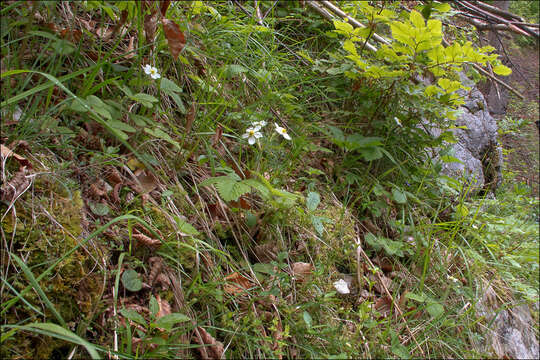Fragaria-moschata_1

Description :
Fragaria moschata Duchesne, syn.: Fragaria elatior Ehrh., Potentilla moschataHautbois Strawberry, DE: Moschus-Erdbeere, Zimt-ErdbeereSlo.: mukatni jagodnjakDat.: May 15. 2016Lat.: 46.35017 Long.: 13.69354Code: Bot_956/2016_IMG0164Habitat: An opening in mixed wood near a river; power line clearance; moderately inclined mountain slope, northwest aspect; thin, skeletal, calcareous ground; mostly in shade because of narrowness of the valley; relatively cool place; elevation 545 m (1.800 feet); average precipitations ~ 3.000 mm/year, average temperature 6-8 deg C, alpine phytogeographical region. Substratum: soil.Place: Lower Trenta valley, between villages Soa and Trenta, left bank of river Soa, near farm house Trenta 46, East Julian Alps, Posoje, Slovenia EC.Comment: The most common, widespread and well know species of genus Strawberry (Fragaria) is Wild Strawberry (Fragaria vesca). Wherever it grows kids know it (sorry, new it) because of its tasty, aromatic fruits. But few people know that there exist two other very similar looking species of this genus in the Alpine region, actually three of them nowadays . Both Hautbois Strawberry (Fragaria moschata) and Green Strawberry (Fragaria viridis) are much less frequent than Wild Strawberry and in several countries at least partially protected. Both have eatable fruits but, because of their relative rarity, of no practical importance. The third very similar plant is Yellow-flowered-Strawberry (Duchesnea Indica), which is not a species of genus Fragaria at all and 'new comer' from Caucasus Mountains. It is now spreading all around Europe. The first plant in Bovec basin at the mouth of Trenta valley I noticed some 10 years ago. Last year I found a few plants next to my house 15 km inside the valley in the direction north. To distinguish Duchesnea Indica from Fragaria species when it blooms is easy. Its flowers are yellow. But when in fruit its fruits resemble the fruits of Wild Strawberry very much - until you taste them. They are at best without any taste if not unpleasant (however, not poisonous).Most plants of Fragaria moschata are functionally unisexual not perfect (flowers having fertile male and female reproductive organs - stamens and pistils). Flowers of male plants have retarded pistils and female plants have flowers with retarded in sterile stamens.Herbarium: Herbarij Biolokega Intituta Jovan Hadi, SRC ZASU, Index Herbariorum LJS.Ref.:(1) Personal communication with Dr. Igor Dakskobler, Natural History Institute Jovan Hadi, SAZU.(2) M.A. Fischer, W. Adler, K. Oswald, Exkursionsflora fr sterreich, Liechtenstein und Sdtirol, LO Landesmuseen, Linz, Austria (2005), p 486.(3) A. Martini et all., Mala Flora Slovenije (Flora of Slovenia - Key) (in Slovenian), Tehnina Zaloba Slovenije (2007), p 256. (4) D. Aeschimann, K. Lauber, D.M. Moser, J.P. Theurillat, Flora Alpina, Vol. 1., Haupt (2004), p 784.(5) K. Lauber and G. Wagner, Flora Helvetica, 5. Auflage, Haupt (2012), p 266.
Inclus dans les pages suivantes :
- Life
- Cellular (Organismes cellulaires)
- Eukaryota (eucaryotes)
- Archaeplastida
- Chloroplastida (plantes vertes)
- Streptophyta
- Embryophytes
- Tracheophyta
- Spermatophytes (plante à graines)
- Angiosperms
- Eudicots
- Superrosids
- Rosids
- Rosales
- Rosaceae
- Fragaria (Fraisier)
- Fragaria moschata (Fraisier musqué)
Cette image ne figure dans aucune collection.
Informations sur la provenance
- licence
- cc-by-nc-sa
- droit d’auteur
- Amadej Trnkoczy
- photographe
- Amadej Trnkoczy
- original
- fichier de média d’origine
- visiter la source
- site partenaire
- Flickr Group
- ID


